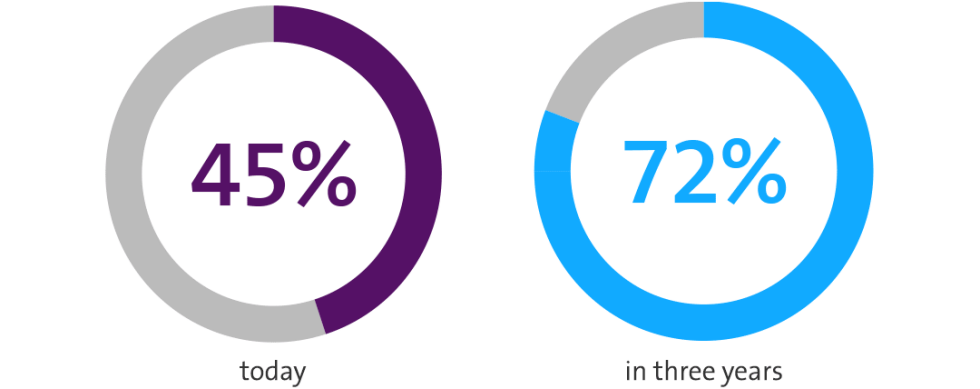
A device with sensors, a network for transmitting data, and a system that can process this to trigger actions. These are the components of the Internet of Things. It sounds complex, but we are in fact already using it to simplify lots of things. For example, car parks transmit their occupancy, recycling containers show their fill level or heating systems highlight possible failures.
There is huge potential in the Internet of Things. According to market researchers, by 2023, several billion ‘things’ will have been networked worldwide. Some sources claim that, even today, the number of networked things has already surpassed the number of smartphones in use worldwide. Network equipment supplier Ericsson is forecasting an annual growth in IoT devices at a rate of 20 percent for local IoT devices, and 30 percent for wide area IoT. By contrast, mobile phones have only grown by three percent.
5G opens up new opportunities for IoT, especially in terms of the number of possible IoT devices in a cell. It is not surprising that the large technology providers, hardware manufacturers and chip developers are increasingly concentrating on developing IoT-specific components such as microchips or data and analysis platforms. Another buzzword is IoT Edge – pre-processing directly at the point of origin before data is transferred In line with this, the Internet of Things is becoming increasingly important for companies too. The current IDG study “Internet of Things 2019” shows that the number of companies in Germany that have already implemented an IoT project has more than doubled within one year (from 21 to 44 percent) – mostly under the banner of Industry 4.0. Swiss companies also see the importance of engaging with IoT.
Increasing importance

72% of companies are convinced that IoT will be important to them over the coming three years. The current level is 45%. Source: IOT Study CIO
IoT applications are equally attractive to companies and customers. Customers benefit from new attractive products and services with added value. Companies can simplify processes, which allows them to increase efficiency, strengthen their market position or even tap new markets.
It all starts with the data
Data is at the heart of any IoT project. The Internet of Things allows this data to be collected: machinery status, environmental data, locations of things and much more. In itself, this data is generally worthless if not analysed and utilised further and turned into useful information. Data management is therefore just as important: The right information needs to be available at the right time and the required speed. IoT management and integration platforms based on cloud technologies make this possible. These connect devices, applications and users, making sure that the data can be saved, processed and integrated.
The true potential lies in the ecosytem
Swisscom was on board with the IoT right from the start and already has 15 years of experience to look back on. It all began with applications based on mobile telecommunications. In 2016, Swisscom was one of the first providers in the world to develop a dedicated national network for IoT. The Low Power Network (LPN) currently offers 96.6% Switzerland-wide population coverage. LPN is a network for the Internet of Things. Its main advantages are energy-efficient transmission and broad coverage.

Julian Dömer, Head of IoT in Swisscom Enterprise Solutions: “In five years’ time, IoT will have as much impact on the economy and society as the smartphone has had over the past 10 years.”
Swisscom has now expanded its portfolio to include new access technologies and management platforms. Since autumn, the mobile technology-based IoT access technologies Narrow Band and Cat M1 (see box) have been live throughout Switzerland. IoT projects increasingly require global coverage and connectivity, which is why Swisscom has introduced an additional platform (CMP Vodafone).
This agnostic approach is unique: Customers are not forced to decide on a standard solution due to a lack of alternatives; they receive exactly the right components and technologies required for their IoT solution. A coffee machine that is sold worldwide has different requirements to a meter for stationary use.
Swisscom also has an extensive network of partners to support all stakeholders, from start-ups and SMEs through to large enterprises. “We realised early on that IoT on its own would always remain small,” says Julian Dömer, Head of IoT. For an IoT project to take off, it requires technology, infrastructure and operation. We can do that really well. However, you also need a functioning ecosystem of suppliers, programming, networks etc. with an understanding of detailed business logic. That is why Swisscom now operates in line with the principle: local contact persons supporting global solutions.”
Examples of current areas of application
NeoVac ATA AG – Home of Metering
NeoVac ATA is a leader in heat and water metering and billing in buildings. Previously, the meters were read by wireless or wired systems in every apartment. If we look back even further, a technician was required to read the meter on site once a year. Now the meters are equipped with sensors, connected via LPN, which transmit the data to the control centre. The existing receiver stations (gateways) can, in turn, be used to expand Swisscom’s indoor network, connecting further elements within a building, such as fire extinguishers or heaters.
University of Applied Sciences and Arts of Southern Switzerland (Supsi)
The Asian tiger mosquito is extremely aggressive and even bites during the day. Although originally native to Southeast Asia, this species has now spread to many countries and is known to spread diseases such as dengue fever. In Switzerland, the tiger mosquito has already spread throughout Ticino. By laying its eggs in sewer shafts, it ensures the continued survival of the species despite cold and wet weather conditions. From January 2019, the University of Applied Sciences and Arts of Southern Switzerland will use sensors to monitor shafts in Lugano, Lausanne, Zurich and Basel. The research will focus on the relationship between temperature and the number of tiger mosquitoes as well as other parameters in the corresponding regions.
Nexiot
Federal Institute of Technology spin-off Nexiot networks international shipping containers, freight cars, pallets or packages for the digitisation of industrial logistics and the monitoring of valuable goods. Nexiot relies, in particular, on Swisscom’s 700 roaming partners, which allow it to network its objects around the world.
Ypsomed
In a pilot project with Swisscom, the medical technology manufacturer Ypsomed has created a 5G test network and digitised the entire process chain: from the delivery of raw materials and product manufacture through to provisioning and supply. Indoor localisation also makes it possible to follow the goods through the entire production process – enabling ground-breaking opportunities for quality, logistics and customisation. The project is a perfect example of the opportunities available through 5G and IoT.
Carbosense
Carbosense is a collaboration involving Empa, the Swiss Data Science Center (SDSC), Decentlab and Swisscom. The project uses more than 200 sensors in Switzerland to measure changes in CO2 concentration. For the first time, it is providing evidence for previous assumptions – such as higher pollution levels along transport routes. The facts improve understanding of the CO2 exchange between the atmosphere and biosphere and also provide possible starting points for traffic planning, health prevention or the development of smart cities.
The relationship between temperature and number of tiger mosquitoes in the corresponding regions.
Narrow Band IoT and Cat M1
After extensive pilot testing, Swisscom launched the IoT access technologies Narrow Band-IoT (NB-IoT) and Cat M1 in the mobile network. These expand the existing Low Power Network. Both technologies enable broad coverage, scalability, availability and security for low networking costs. They also offer real alternatives to 2G, which will be discontinued in 2020, and are 5G-compatible.
Read the brochure
Narrow Band-IoT and Cat M1 are ideal for residential customer applications, such as security and surveillance systems, emergency call applications or wearables. A recent example is the Trax tracker. The GPS tracker is simply attached to the pet’s collar and allows the pet to be tracked via the compatible app wherever it roams. It is particularly useful for dogs with a strong hunting instinct or flight reflex.
Go to tracker
Swisscom Enterprise IoT
Swisscom Enterprise IoT is the modular and scalable technology platform for all IoT projects. It is aimed at companies of any size – from start-ups and SMEs through to large enterprises. A major focus is on the optimum mix of partners within the IoT ecosystem. Both 1:1 demos and advice are offered at the IoT Experience Centers in Zurich and Lausanne.
Find out more
Subscribe to news
Subscribe to our news by e-mail
Contact us
Address
Swisscom
Media Relations
Alte Tiefenaustrasse 6
3048 Worblaufen
Postal address:
Postfach, CH-3050 Bern
Switzerland
Contact
Tel. +41 58 221 98 04
media@swisscom.com

